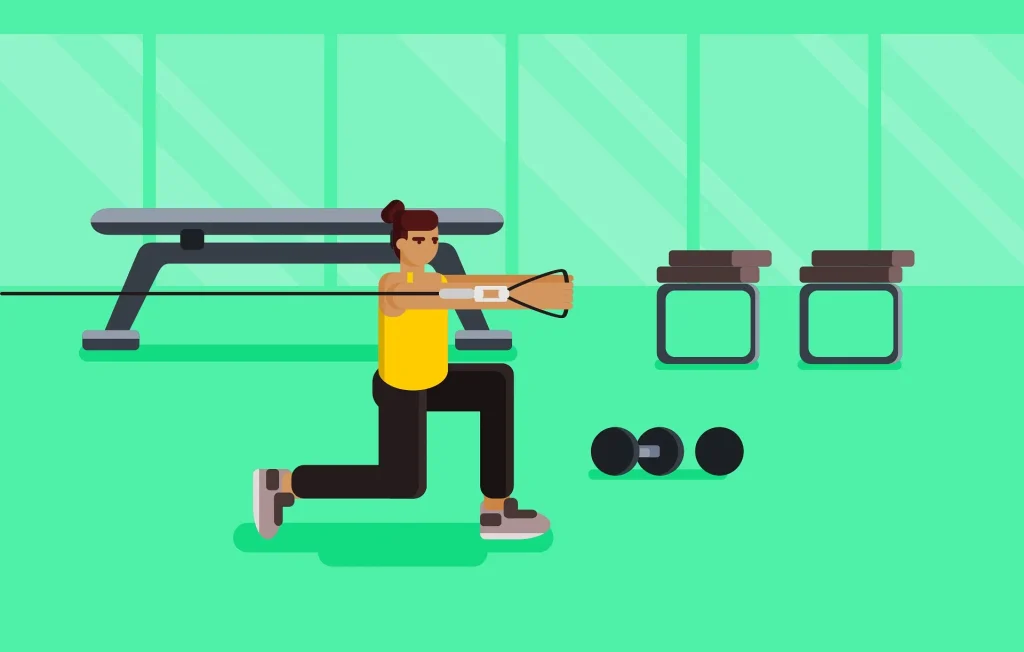A DOZEN people are in motion at a Crunch Fitness in a Midtown Manhattan basement, sneaking in a lunch-hour workout. A young woman at a gleaming silver squat rack balances an iron bar across her back, two bright-red rubber weights on each end. A few yards away, a young man flicks through his phone between deadlift sets. Behind the lifters is a sea of gray-painted machines designed to build leg muscles, including new plate-loaded hack squat machines. Across the expansive bottom floor of the three-storey gym, a few more members crunch and curl and pull weights around.
Upstairs, several new high-tech treadmills sit mostly idle.
During busy hours every lifting platform will be occupied, according to general manager Rudy Sanchez. “The good news is that it’s packed and no one is complaining,” he says. That wasn’t always the case: Last year the gym did a US$2 million renovation to convert a yoga studio into more lifting stations and add a slew of new weights. “We get less complaints that people are hogging equipment,” Sanchez says. “There’s no fights.”
Similar transformations are happening at fitness centres across the US as they attempt to attract an increasingly muscle-obsessed population. Since 2021, Google searches for cardio workouts have declined on average by 3 per cent year over year each month, while interest in strength-focused routines has grown 6 per cent. Both Crunch Holdings LLC and Planet Fitness Inc say they’re reducing cardio equipment by more than 40 per cent at many locations. That could mean big changes at the more than 90,000 fitness locations in the US, which generated US$41.8 billion in sales last year, according to IBISWorld data. Even the onetime king of cardio gear, Peloton Interactive Inc, is pushing to increase its strength-focused offerings. In December it launched its Strength+ app, which offers “tailored” weight-training programmes to “maximise your muscle” and “build size”, including audio instructions and goal tracking. In the fourth fiscal quarter, the company said during its February earnings call, its customers were already doing almost as many muscle-building workouts as cycling routines.
“I think the most significant thing is there’s certainly a reduction in the use of cardio – stationary bikes and treadmills and steppers,” says Jim Rowley, chief executive officer of Crunch Fitness, which operates more than 460 US locations. “We used to have clubs with 100 pieces of cardio that are probably down to 60 at this point because they’re just not being used.”

The message from Americans is simple: Jogging on a treadmill or sweating over a stationary bike in a room full of strangers is out; moving heavy objects is in. But, in a twist, it’s not muscle-bound men who are changing America’s workouts. It’s women and older Americans who’ve made gyms prioritise strength training. “More older people, more women, more young people, even, are lifting weights than ever before,” says fitness author and influencer Casey Johnston. “When I started lifting, there was still a lot of apprehension around it in terms of ‘it’s really macho, it’s too intense for most people’.”
A NEWSLETTER FOR YOU

Friday, 2 pm
Lifestyle
Our picks of the latest dining, travel and leisure options to treat yourself.
That shift has been evident at Crunch Fitness locations too, according to Rowley, where women make up 45 per cent of membership. “You would think, with the old way of thinking, that a lot of the Olympic-style lifting – deadlift, squats, those sort of things – would be very male-dominated,” he says. “Not anymore. More than 50 per cent of the usage of the lifting platforms is female.” The future of weightlifting, it seems, is female.
Throughout the 1970s and ’80s, running and jogging dominated physical fitness, as advertising about the benefits of cardio exercise proliferated. In 1967 legendary track coach and future Nike Inc co-founder Bill Bowerman published the book Jogging, “a detailed instructional guide” that espoused the benefits of running and launched the “jogging craze” in America. Five years later, Bowerman and Phil Knight introduced the Nike Cortez running shoe, bringing the latest technology to average Americans looking to get in on the trend. Then came the 1982 introduction of Jane Fonda’s iconic aerobic workout tapes, a franchise that would sell millions of copies and get Americans hooked on her heart-pounding routines. Richard Simmons’ Sweatin’ to the Oldies, Billy Blanks’ Tae Bo and other VHS workout tapes kept cardio at the forefront of fitness.
Weightlifting, for the most part, remained on the fringes of society. It was the preserve of giants like the ones in the 1977 documentary Pumping Iron, which showcased a young Arnold Schwarzenegger and other impossibly sculpted demigods hefting massive weights under the California sun.
“In the West we have muscular statues dating back for 3,000 years, a tradition of muscularity going back to classic times,” says Dr Harrison Pope, a professor of psychiatry at Harvard Medical School and author of The Adonis Complex. But as Schwarzenegger, Hulk Hogan and others became stars in the 1980s, more boys and men got interested in looking jacked. The transition was evident even in GI Joe action figures, which went from svelte to hulking over the past half-century.
“We’ve seen a gradual proliferation of muscular bodies in Hollywood movies and television dramas and cartoons and magazine advertisements,” Pope says. “You and I see these muscular bodies, these muscular images around us so often that we hardly even notice them any longer because they’ve become so ubiquitous.”
That said, for the most part, cardio remained ascendant at gyms. Bulking up is hard, and it takes a while to see real gains. Pope notes that the rise in muscularity during the ’90s was fuelled in part by the proliferation of anabolic steroids. For most people, that kind of shortcut was a nonstarter.
The current fixation is being triggered largely by social media. If the treadmill is dying, Internet influencers are the killers. Open most apps, and the message is clear. For men, bulging biceps and broad shoulders. For women, toned arms and sculpted glutes. “Swole” is the marker of peak physical health.
Pope, whose work tracks the rise of body dysmorphia in men, suspects social media is driving this trend to unhealthy degrees at times. Viewing hunks online may have created “an increased wave of body image concern among young men in Western societies”, he says.
There are more than 72 million posts with the hashtag #fitspo – short for “fitness inspiration” – on Instagram, while TikTok’s version, #fittok, has more than 62 billion views, according to one study analysing online fitness content published in December.
Gyms across the country are just catching up with their clientele. Until recently, entering the average American gym meant taking a “step back in time” to a “treadmill forest”, according to Maik Wiedenbach, a boutique gym owner in New York City and former competitive bodybuilder.
The Covid-19 pandemic was partly responsible: More than 11,000 gyms closed in 2020, according to IBISWorld data. Dan Wille, chief product officer at gym equipment maker Life Fitness / Hammer Strength, says that forced many people who could no longer run on treadmills to experiment instead with low-weight workouts at home. In many cases, those experiments became new routines. By the time gyms were reopening, Wille says, some people had realised, “Actually, you can get a pretty good workout—both strength and cardio—by doing strength activity.” For Life Fitness, strength equipment has become “a larger percentage of our portfolio”, he says.
That tracks with what’s happening at Planet Fitness, the country’s largest publicly held gym chain, with nearly 2,600 locations dotted across the map in the US. The company began removing cardio gear from some gyms in 2023, culling in stages to gauge how little was too little for members. After the initial round of cuts, “we did not see a threshold of usage that was a problem”, says chief operating officer Bill Bode. “So we lowered it again.” After building 20 new locations with “significantly” fewer cardio options in 2024, the company ultimately decided 50 cardio pieces was too low – the optimal number was in the mid-60s, Bode says.

Removing cardio gear cleared up real estate for more plate-loaded equipment – brutish-looking apparatuses used by serious weight-training types – and open areas meant for functional training to complement the free weights and pin-selection machines. Planet Fitness quickly got 1,700 franchise locations on board with the changes and expects all of its gyms to have the extra iron by yearend, Bode says. The company’s stock is down about 4 per cent this year, outperforming the S&P 500, which is down 10 per cent.
The chain has started to emphasise its strength offerings in a new marketing campaign. The new strength gear keeps “clubs more relevant for today’s members, so they don’t feel like they need to graduate to another gym”, CEO Colleen Keating said during an earnings call in February.
The increasing number of women and older people getting into weightlifting has been a striking cultural change. Wiedenbach, the New York gym owner, recalls that gyms were more gender-segregated in the early 2000s. “Back then it was very much split: There were treadmills – those were for girls – and there were weights, and those were for guys. And never the two groups would meet,” he says. In those days women made up just 10 per cent of his clientele; now it’s closer to 40 per cent.
Older Americans are hitting the weight room more often too. “Everybody talks about longevity now, and having strength and having muscle mass is a key indicator in longevity,” says Noam Tamir, founder and CEO of TS Fitness, which offers small workout classes in Manhattan.
As people age, their bone density and metabolic health – what doctors are monitoring when they check blood pressure, cholesterol and weight – decline. Weight training can help manage both issues; cardio, less so. “Cardio is great for heart health, but muscle mass has really helped people with the quality of life that they will have, because there’s a lot more people living into their 80s and 90s,” Tamir says. Wider understanding of the scientific benefits means strength training’s rise will be more permanent than the average fitness fad, says Johnston, the influencer and author. “Now that we know muscle mass is not just an aesthetic thing,” she says, “it’s really a wellbeing thing for everyone.” BLOOMBERG


